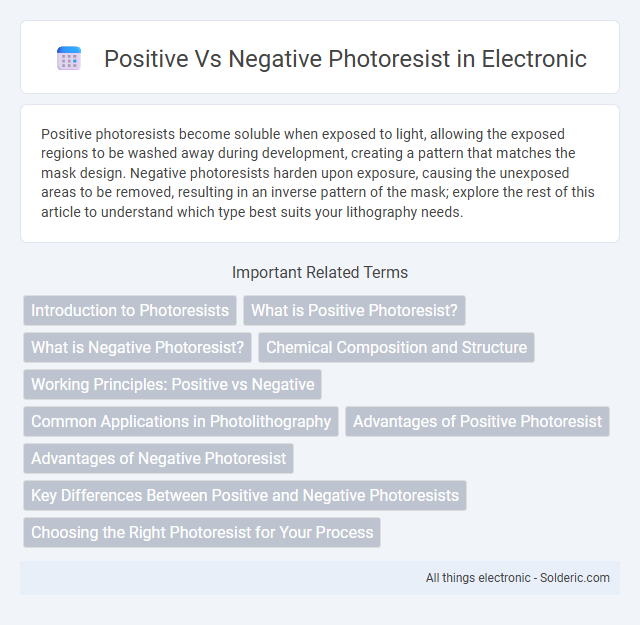Positive photoresists become soluble when exposed to light, allowing the exposed regions to be washed away during development, creating a pattern that matches the mask design. Negative photoresists harden upon exposure, causing the unexposed areas to be removed, resulting in an inverse pattern of the mask; explore the rest of this article to understand which type best suits your lithography needs.
Comparison Table
| Aspect | Positive Photoresist | Negative Photoresist |
|---|---|---|
| Definition | Becomes soluble where exposed to light | Becomes insoluble where exposed to light |
| Exposure Effect | Exposed areas are removed during development | Exposed areas remain after development |
| Resolution | Higher resolution, sharp patterns | Lower resolution, thicker, rough edges |
| Pattern Type | Useful for fine, precise circuit patterns | Better for large, simple patterns |
| Processing Complexity | More complex development process | Simpler development |
| Common Applications | IC fabrication, microelectronics | PCB manufacturing, MEMS |
| Chemical Composition | Typically novolak resin with diazonaphthoquinone (DNQ) sensitizer | Typically polymerizable resin (e.g., epoxy) |
| Feature Stability | Less resistant to etching | More resistant to etching |
Introduction to Photoresists
Photoresists are light-sensitive materials crucial in photolithography, used to transfer patterns onto semiconductor substrates during microfabrication. Positive photoresists become soluble when exposed to light, allowing the exposed regions to be washed away, while negative photoresists harden upon exposure, making the unexposed regions removable. The choice between positive and negative photoresists depends on factors like resolution requirements, processing conditions, and the desired pattern profile in integrated circuit manufacturing.
What is Positive Photoresist?
Positive photoresist is a light-sensitive material used in photolithography that becomes soluble when exposed to ultraviolet light, allowing selective removal of the exposed areas during development. This characteristic enables precise pattern transfer from a photomask onto a semiconductor wafer, essential for integrated circuit fabrication. Positive photoresists typically offer high resolution and straightforward processing compared to negative photoresists, which become insoluble upon exposure.
What is Negative Photoresist?
Negative photoresist is a type of light-sensitive material used in photolithography that becomes insoluble when exposed to ultraviolet (UV) light, allowing the exposed areas to remain on the substrate after development. This property enables the creation of patterns where the illuminated regions define the final structure, making it ideal for applications requiring high-resolution and durable patterns. Your choice of negative photoresist depends on factors such as adhesion, resolution, and chemical resistance needed for specific microfabrication processes.
Chemical Composition and Structure
Positive photoresists typically consist of novolac resin combined with a diazonaphthoquinone (DNQ) photosensitizer, where exposure to light breaks the DNQ into a carboxylic acid, rendering the exposed areas soluble in alkaline developers. Negative photoresists are mainly composed of polymeric compounds like polyisoprene or phenolic resins that cross-link or harden upon UV exposure, making exposed areas insoluble and leaving unexposed regions removable. Understanding the chemical composition and structural differences in your photoresist selection directly impacts the resolution and pattern fidelity of your photolithography process.
Working Principles: Positive vs Negative
Positive photoresist works by becoming soluble when exposed to UV light, allowing the exposed areas to be washed away during development, while negative photoresist hardens upon exposure, causing the unexposed regions to be removed instead. This fundamental difference in chemical response drives their distinct applications in photolithography processes. Your choice between positive and negative photoresist depends on the desired pattern resolution and process compatibility.
Common Applications in Photolithography
Positive photoresist is predominantly used in microelectronics for defining intricate circuit patterns due to its high resolution and ease of removal in exposed areas. Negative photoresist finds common applications in MEMS fabrication and thick film patterning, offering chemical resistance and better adhesion for three-dimensional structures. Both types play critical roles in semiconductor manufacturing, but the choice depends on pattern complexity and processing requirements.
Advantages of Positive Photoresist
Positive photoresist offers precise pattern transfer with high resolution, making it ideal for intricate semiconductor manufacturing and microfabrication processes. It enables easier defect detection and correction during lithography due to its direct correlation between exposed areas and removed material. This type of photoresist also provides better adhesion and compatibility with various developers, enhancing overall processing efficiency and yield.
Advantages of Negative Photoresist
Negative photoresist offers significant advantages such as higher chemical resistance and better adhesion to substrates, making it ideal for robust microfabrication processes. Its ability to produce thicker films enables the creation of high-aspect-ratio structures essential in MEMS and printed circuit board applications. Additionally, negative photoresists generally provide improved mechanical strength and flexibility during development, leading to fewer defects and enhanced pattern fidelity.
Key Differences Between Positive and Negative Photoresists
Positive and negative photoresists differ primarily in their reaction to UV light exposure: positive photoresists become soluble where exposed, allowing the exposed regions to be washed away, while negative photoresists harden and remain after exposure, with unexposed areas removed during development. The resolution of positive photoresists is typically higher, making them suitable for fine patterning, whereas negative photoresists generally offer better adhesion and are more resistant to etching processes. Understanding these key differences can help you select the appropriate photoresist for precise semiconductor fabrication or microfabrication applications.
Choosing the Right Photoresist for Your Process
Selecting the right photoresist depends on the specific lithography process and desired resolution; positive photoresists dissolve in the exposed areas, offering high precision suitable for fine patterning and semiconductor fabrication. Negative photoresists harden when exposed to light, providing better adhesion and chemical resistance, ideal for applications requiring thicker coatings and durability. Consider factors such as substrate compatibility, exposure dose, development time, and feature size to optimize pattern fidelity and process efficiency.
Positive vs Negative Photoresist Infographic

 solderic.com
solderic.com